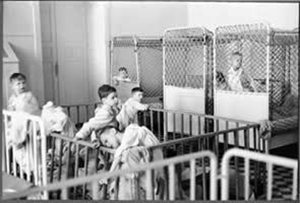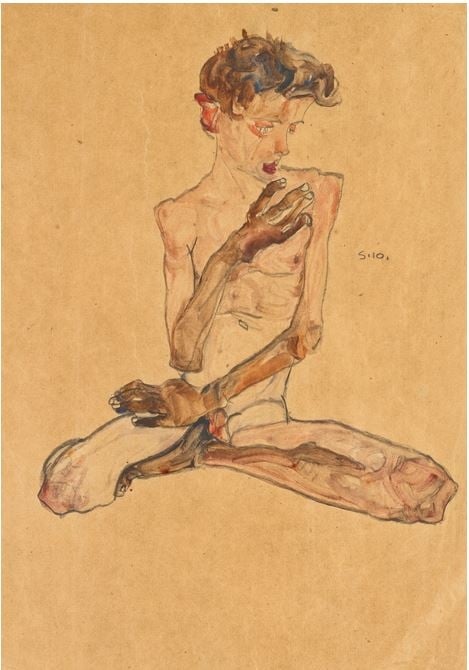by Daniel Mallock (June 2018)
Seated Boy, Egon Schiele, 1910
Asperger’s Children: The Origins of Autism in Nazi Vienna by Edith Sheffer, (W. W. Norton & Company; May 1, 2018, 320 pp) is an important and disturbing book. It is thoroughly researched, engagingly written, and handles its disturbing material with fairness and compassion. The compassion is reserved for the child victims murdered and tortured by Nazi doctors and medical staff—not for the perpetrators themselves.
Though the author acknowledges the difficulties of navigating and surviving in a world turned upside down where decency and the essential human drivers of love and empathy and compassion for the innocent are overturned—no excuses for the miserable behavior of the Austrian medical killers are offered.
The Nazi origins of “Asperger’s Syndrome” and the reprehensible crimes that occurred around that diagnosis are not generally known. Ms. Sheffer performs an important service by reconnecting a widely recognized psychiatric concept and diagnosis that now impact millions to their disturbing origins.
 The book serves as a warning that categorizing children, particularly when that categorization is in service to the state rather than the child/patient, can be used as a means of controlling or eliminating people. In the Nazi environment of mass murder and social and societal engineering, the “fitness” of a child patient or lack of it was sometimes the determinant of life or death. Asperger’s Children, in a manner similar to Robert Lifton’s seminal The Nazi Doctors: Medical Killing and the Psychology of Genocide, catalogues the nightmares that arise when medicine is perverted and the hippocratic oath abandoned.
The book serves as a warning that categorizing children, particularly when that categorization is in service to the state rather than the child/patient, can be used as a means of controlling or eliminating people. In the Nazi environment of mass murder and social and societal engineering, the “fitness” of a child patient or lack of it was sometimes the determinant of life or death. Asperger’s Children, in a manner similar to Robert Lifton’s seminal The Nazi Doctors: Medical Killing and the Psychology of Genocide, catalogues the nightmares that arise when medicine is perverted and the hippocratic oath abandoned.
Until the 1980s, Asperger’s work had been all but forgotten. For whatever reason, the doctor who reintroduced Asperger and his Nazi-era work to the world failed to include the introduction to Asperger’s thesis which showed conclusively that Asperger’s “syndrome” (a word not used by Asperger himself—he preferred the term “psychopathy”) was determined entirely within a Nazi context.
. . . Asperger framed his work with the ideas of Nazi child psychiatrists and Gemüt in the introduction. And it is these Reich concepts that provided the basis for Asperger’s ultimate definition of autistic psychopathy” (p.215)
Those children who were “ineducible” or lacking in Gemüt (a Nazi psychiatry conception of the ability of an individual to interact functionally if not normally with others with empathy, compassion, and obedience to authority inclusive of the ability to work) were considered burdens on the state and their parents and were thus often put to death. Dr. Asperger had no compunctions in identifying some of his patients as ineducible or lacking in acceptable levels of Gemüt. That such diagnoses were entirely unscientific and subjective adds to the troubling nature of this subject.
Diagnoses that are so heavily weighted that they might carry a state-sponsored death sentence are all too susceptible to bias, whim, pique, and to external political and social pressures.
Diagnoses reflect a society’s values, concerns, and hopes. As this book uncovers the nightmarish contexts of autism’s creation, it reveals how what today appears to be a singular idea rested upon the community that made it. Asperger’s diagnosis of autistic psychopathy emerged from the values and institutions of the Third Reich. (p.13)
Dr. Asperger was supposedly a practicing Catholic and did not join the Nazi party. His non-membership likely saved him from later post-war legal problems. He was however deeply involved in sending children from his clinic to Spiegelgrund where many were murdered. He was fully aware that a child transferred from his clinic to Spiegelgrund would likely be killed. Dr. Asperger never answered for these crimes.
Approximately 800 children were killed by the Nazi doctors and nurses at Spiegelgrund. Doctor Asperger was a component of the vile nightmare that was Nazism. Though not a party member, he was an enthusiastic participant, a willing executioner.
While Asperger did support children he believed to be teachable, defending their disabilities, he was dismissive about those he believed to be more disabled. Deprecatory pronouncements could be a death sentence in the Third Reich. And in fact, some of Asperger’s judgments were death sentences. (p.13)
This is a sometimes painful book to read as it describes state-sanctioned murders of children. The entire Nazi period is an exercise in grotesquery; Asperger’s part in it is not less appalling.
Asperger used it (the autism psychopathy diagnosis) for some children to suggest their humanity; but he used it for others to deny their humanity . . . It got to the heart of what it meant to be human in the Third Reich. (p.176)
There are few stories told in this book of compassion toward the children from the employees of these institutions as there are few to tell.
Asperger’s Children is a direct challenge to the foundations of child psychiatry as it reminds every reader of the persistence and influence of grotesque Nazi medical ethics. The author does not ask a core question: If the diagnostician is tainted by working for the Nazi death machine, is the diagnosis also tainted?
There are painful questions that are hinted at in the book but not deeply explored—such things are the purview of practitioners, ethicists, philosophers, and clergy perhaps? Since Asperger’s diagnosis was developed within the context of the Nazi regime and specifically to serve the state rather than to help/cure/rehabilitate children, is the diagnosis valid? Additionally, if the diagnosis is valid regardless of its origins, how do we come to terms with the crimes perpetrated by the enthusiastic Nazi doctor who developed it using tainted and bloody research?
The book is heavily footnoted, with a detailed index. The bibliography is embedded in the Notes section, an unfortunate new commonality in modern non-fiction pressings. The few illustrations included are sufficient.
 Asperger’s Children shows how easily a society can be overturned to inhumanity and evil in such a short time. It shows much more, too. When institutions are corrupted and long-standing concepts of humanity and compassion are perverted only with the help of the true believers, the ambivalent, and the careerist can the bizarre, anti-humanity, and morally corrupt approaches of the “new order” be implemented. No one forced Asperger to continue working in his clinic after the Anschluss, no one forced him to order transfers to Spiegelgrund. He was a willing, enthusiastic participant in Nazi medicine. Dr. Asperger was not a Nazi party member—for the children he transferred to the killing center this was irrelevant.
Asperger’s Children shows how easily a society can be overturned to inhumanity and evil in such a short time. It shows much more, too. When institutions are corrupted and long-standing concepts of humanity and compassion are perverted only with the help of the true believers, the ambivalent, and the careerist can the bizarre, anti-humanity, and morally corrupt approaches of the “new order” be implemented. No one forced Asperger to continue working in his clinic after the Anschluss, no one forced him to order transfers to Spiegelgrund. He was a willing, enthusiastic participant in Nazi medicine. Dr. Asperger was not a Nazi party member—for the children he transferred to the killing center this was irrelevant.
__________________________________
Daniel Mallock is a historian of the Founding generation and of the Civil War and is the author of Agony and Eloquence: John Adams, Thomas Jefferson and a World of Revolution. He is a Contributing Editor at New English Review.
More by Daniel Mallock.
Follow NER on Twitter @NERIconoclast
- Like
- Digg
- Del
- Tumblr
- VKontakte
- Buffer
- Love This
- Odnoklassniki
- Meneame
- Blogger
- Amazon
- Yahoo Mail
- Gmail
- AOL
- Newsvine
- HackerNews
- Evernote
- MySpace
- Mail.ru
- Viadeo
- Line
- Comments
- Yummly
- SMS
- Viber
- Telegram
- Subscribe
- Skype
- Facebook Messenger
- Kakao
- LiveJournal
- Yammer
- Edgar
- Fintel
- Mix
- Instapaper
- Copy Link









